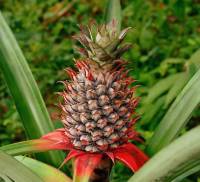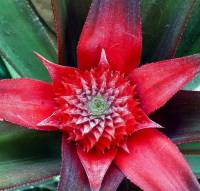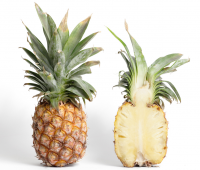Pineapple
Botanical Information
| Botanical Information | |
|---|---|
| Order | Poales |
| Family | Bromeliaceae |
| Genus | Ananas |
| Common Name | Pineapple |
| Species | A. comosus |
Maturity days
- 360
Planting Months
| Planting months | |||||||||||
|---|---|---|---|---|---|---|---|---|---|---|---|
| Jan | Feb | Mar | Apr | May | Jun | Jul | Aug | Sep | Oct | Nov | Dec |
| X | X | X | X | X | X | X | X | X | X | X | X |
Permaculture uses
| Permaculture uses | ||
|---|---|---|
| Usage 1 | Usage 2 | Usage 3 |
| Fruit | ||
Growing condition comments
| Growing Condition | Comment |
|---|---|
| Drought Tolerant | Yes |
| Humidity tolerant | No |
| Planting area | Ground |
| Sunlight | Full_sun |
Photos
Short comments
Grows in Rollingstone north of Townsville
General comments
The pineapple is a tropical plant with an edible fruit and the most economically significant plant in the family Bromeliaceae. Pineapples grow as a small shrub; the individual flowers of the unpollinated plant fuse to form a multiple fruit. The plant is normally propagated from the offset produced at the top of the fruit, or from a side shoot, and typically mature within a year. In the wild, pineapples are pollinated primarily by hummingbirds.
Under cultivation, because seed development diminishes fruit quality, pollination is performed by hand, and seeds are retained only for breeding. The fruit itself is quite perishable and if it is stored at room temperature, it should be used within two days; however, if it is refrigerated, the time span extends to 5–7 days.
The pineapple is a herbaceous perennial, which grows to 1.0 to 1.5 m tall, although sometimes it can be taller. In appearance, the plant has a short, stocky stem with tough, waxy leaves. When creating its fruit, it usually produces up to 200 flowers, although some large-fruited cultivars can exceed this. Once it flowers, the individual fruits of the flowers join together to create a multiple fruit. After the first fruit is produced, side shoots (called 'suckers' by commercial growers) are produced in the leaf axils of the main stem. These may be removed for propagation, or left to produce additional fruits on the original plant.


